Episode 214: HubSpot for COVID tracking, In-App Notifications, and you have no privacy
Welcome to HubShots Episode 214: HubSpot for COVID tracking, In-App Notifications, and you have no privacy This episode we discuss having no privacy,...
If you're new to HubSpot, we guide you on where to start, how to do it right, and train you to make the most of the platform.
Review your HubSpot portal to uncover issues, spot growth opportunities, and ensure you're maximising its potential.
Unlock business growth with automation and attribution. Implement best practices and execute marketing campaigns.
HubSpot On-Demand
HubSpot Training
HubSpot Websites
HubSpot Campaigns
Virtual HubSpot Manager
19 min read
XEN Systems 31 July 2020 12:43:56 PM
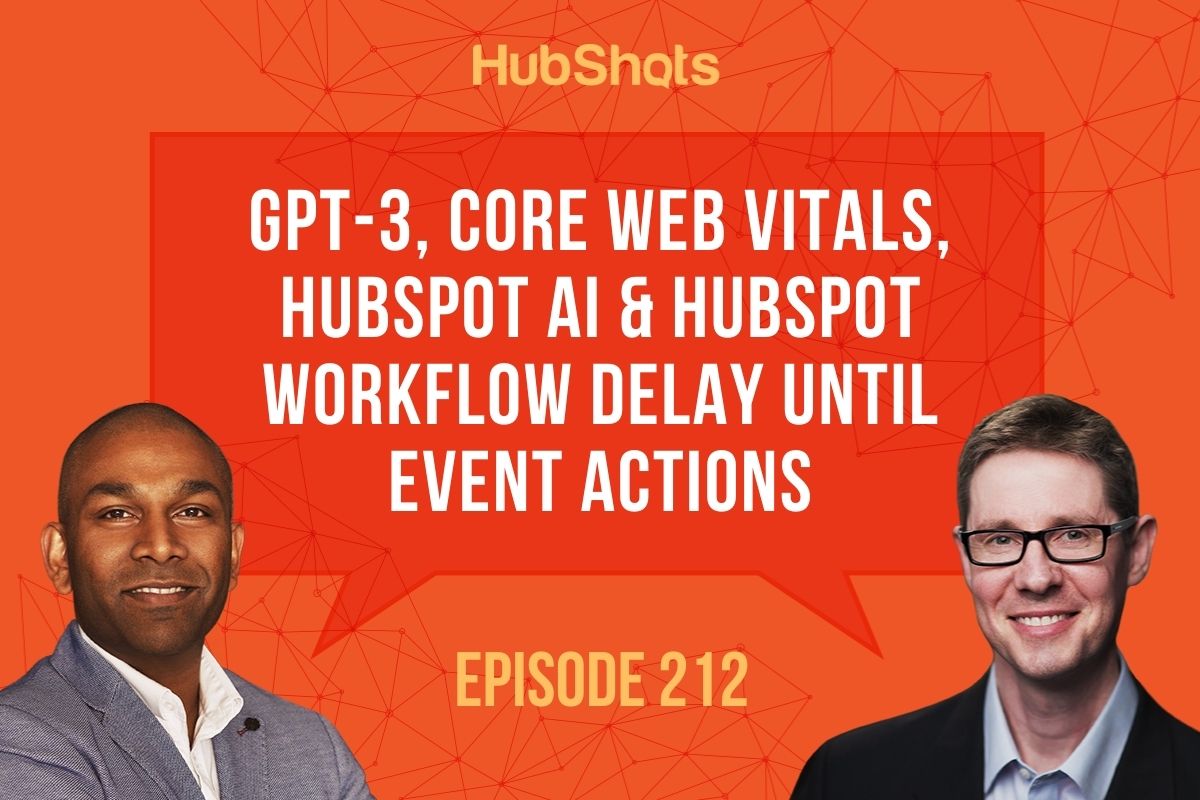
This episode we discuss GPT-3, Core Web Vitals, HubSpot AI, HubSpot Delay until Event Workflow Actions, plus a Drag and Drop email gotcha.
Listen to the episode here: https://soundcloud.com/hubshots/212-gpt-3-core-web-vitals-hubspot-ai-hubspot-workflow-delay-until-event-actions
Welcome to HubShots - APAC's number 1 HubSpot focussed podcast - where we discuss HubSpot tips & tricks, new features, and strategies for growing your marketing results.
HubShots, the podcast for marketing managers and sales professionals who use HubSpot, hosted by Ian Jacob from Search & Be Found and Craig Bailey from XEN Systems.
Recorded: Thursday 23 July 2020 | Published: Friday 31 July 2020
Thank you to our listeners and those who leave us reviews. Here is one recently:
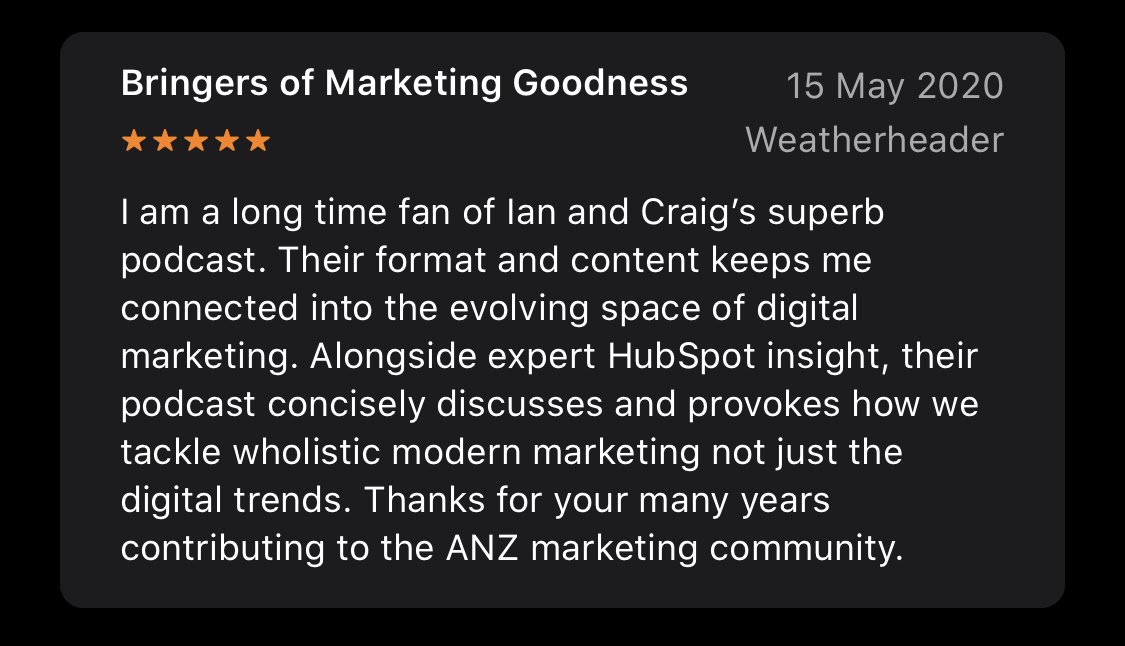
There’s been lots of talk about GPT-3 in the past few weeks. What is it and why all the fuss?
GPT-3 is the next iteration of the artificial intelligence API developed by Open AI (a company formed by Elon Musk, Sam Altman and others). It has been getting a lot of attention due to the example project people on the beta program have been building.
This is a good example of it GPT-3 in action, and here’s a good overview video from Aaron Jack.
Wired has a good overview with examples.
HubSpot has added another Workflow Delay Action into the mix - this adds to the one we mentioned in episode 206 - this time it is a Delay until Event action:
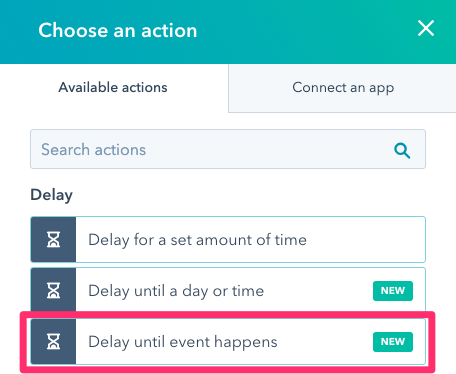
Which gives these options:
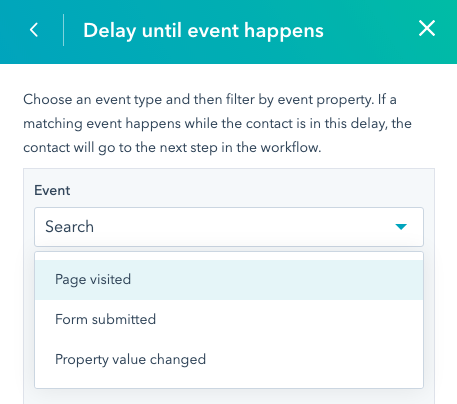
Fun to look with hindsight at some of the community posts that were inspirations for this kind of functionality.
As of recording today, it wasn’t yet in the HubSpot Knowledge Base article.
Follow On from HubSpot AI enablement. Looks like it is working well and saving time on data input! Items like Job Title, etc.
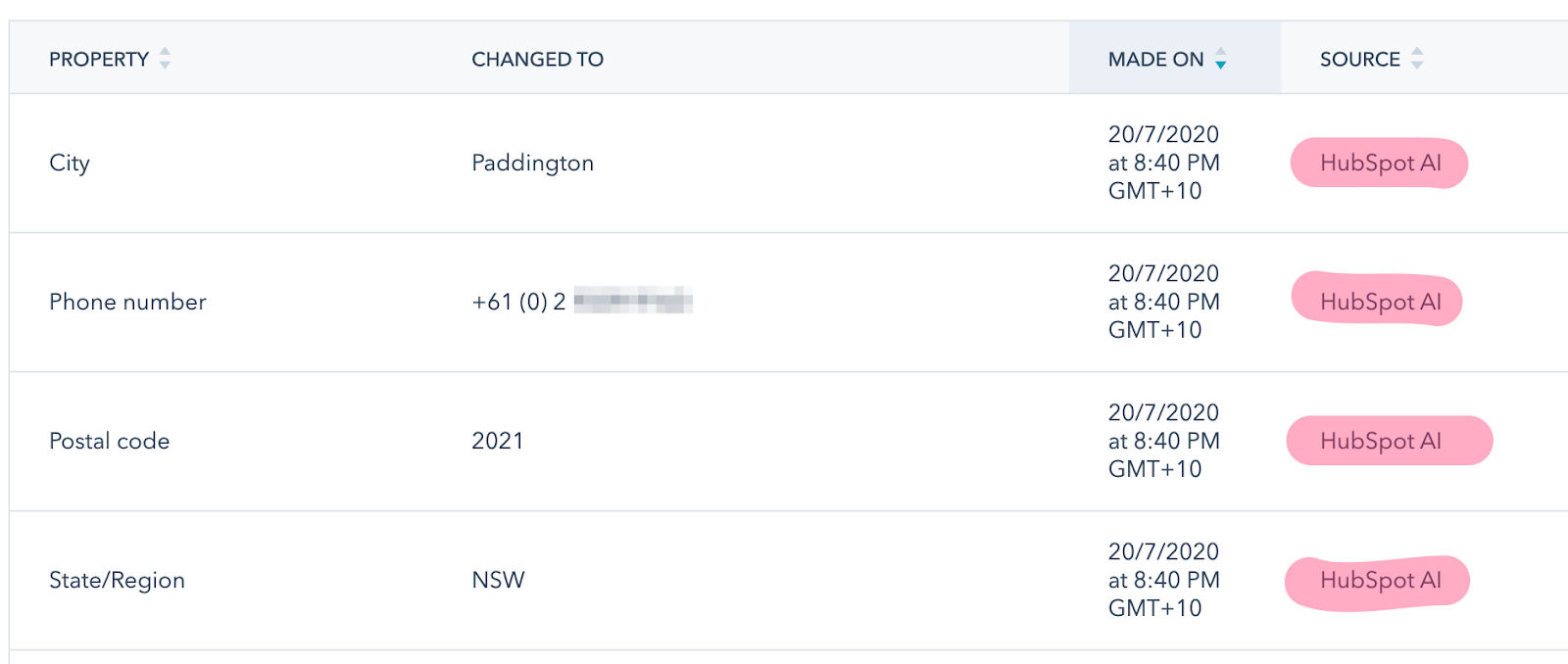
If you are building single column emails (which is becoming best practice - especially since mobile is the main consumption device) it can be easily only drag Modules onto the email canvas - and then get confused as to why you can’t control the styling of the module.
The styling is set at the Layout level - so simply drag on Layout items first, and then add your Modules into them.
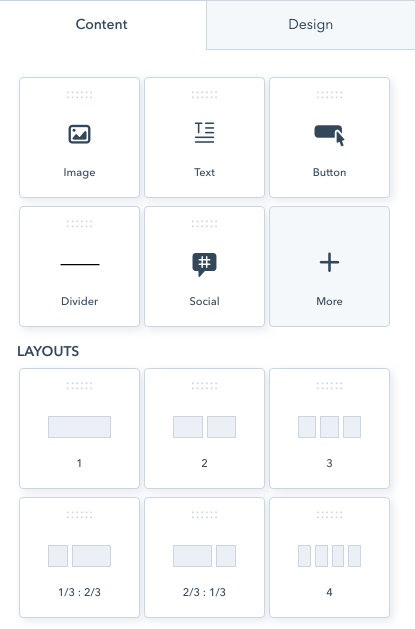
Reminder: To move a lifecycle stage back (eg from SQL to MQL) in a Workflow you need to clear the Lifecycle property first.
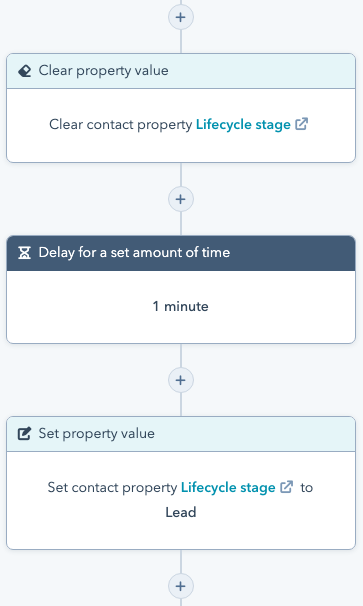
Core Web Vitals: in essence they are real-world user experience metrics when viewing a web site page.
1. Largest contentful paint (LCP)
2. Cumulative layout shift (CLS)
3. First input delay (FID)
They will be part of the ranking algorithm, starting in 2021 (sometime).
Think of it like this: how quickly can I interact with a web page.
See also Google’s blog post where they include stats on the benefits of meeting thresholds:
“The Largest Contentful Paint (LCP) metric measures when a page-to-page navigation appears complete to a user. We recommend sites aim to keep LCP under 2.5 seconds for 75% of their page loads.”
The metrics for your site are available in Google Search Console.
But even guesses can be useful.
A good reminder that studies of data about Google results can be deceptive. Lots of good examples of mistaken study findings in this article from Search Engine Journal.
Love the clear nature of this to take action on items that need attention. In this case unsubscribe rate on one of our accounts!
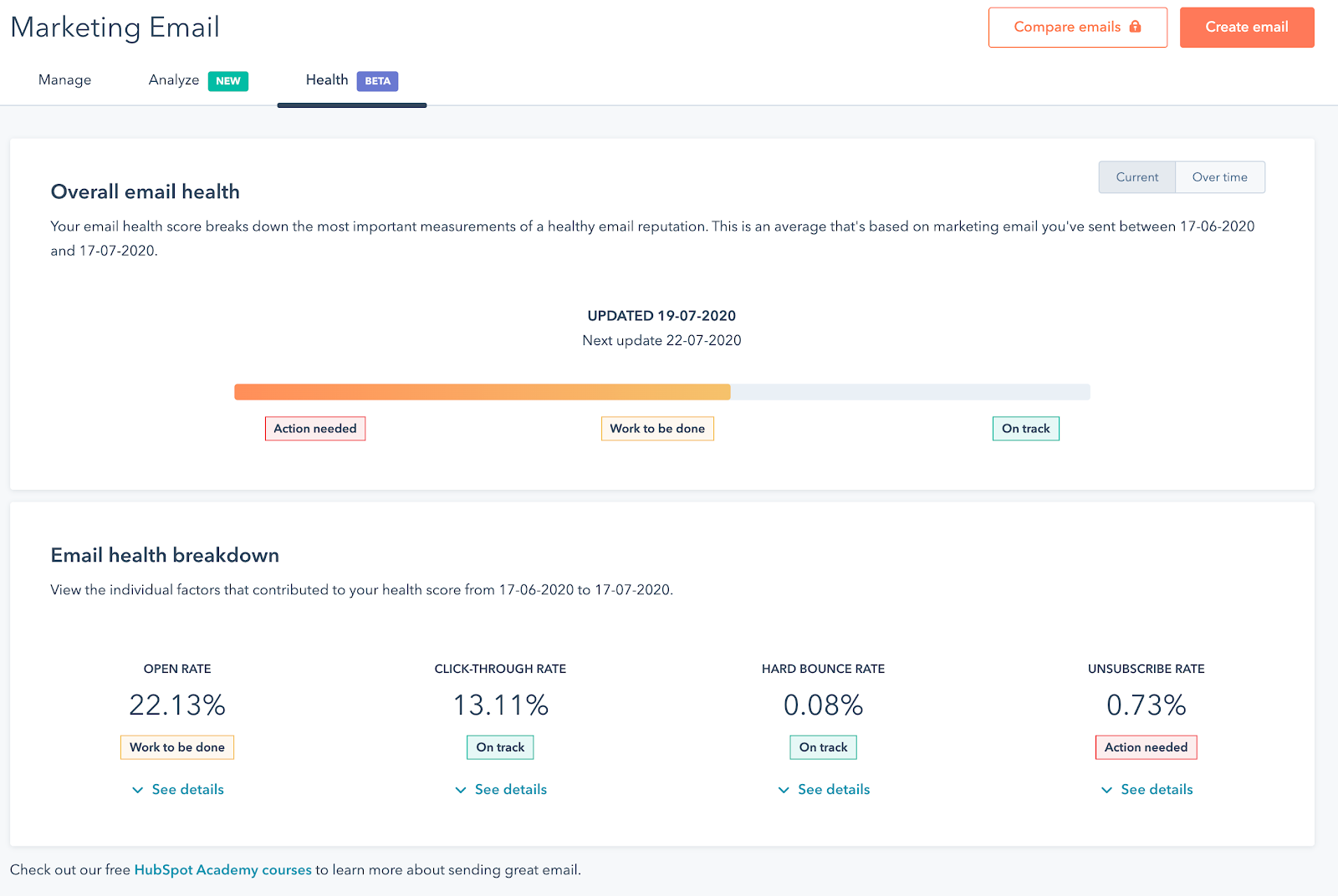
Bing have released a WordPress plugin for easily submitting site URLs to Bing.
Yes, Bing, you should be including it in your activities.
“Waste no more time arguing what a good man should be. Be one.” — Marcus Aurelius
A wonderful thread from a few months ago on Hacker News.
Here’s the opening thread:
Yes, there are tons of resources but I'll try to offer some simple tips.
1. Sales is a lot like golf. You can make it so complicated as to be impossible or you can simply walk up and hit the ball. I've been leading and building sales orgs for almost 20 years and my advice is to walk up and hit the ball.
2. Sales is about people and it's about problem solving. It is not about solutions or technology or chemicals or lines of code or artichokes. It's about people and it's about solving problems.
3. People buy 4 things and 4 things only. Ever. Those 4 things are time, money, sex, and approval/peace of mind. If you try selling something other than those 4 things you will fail.
4. People buy aspirin always. They buy vitamins only occasionally and at unpredictable times. Sell aspirin.
5. I say in every talk I give: "all things being equal people buy from their friends. So make everything else equal then go make a lot of friends."
6. Being valuable and useful is all you ever need to do to sell things. Help people out. Send interesting posts. Write birthday cards. Record videos sharing your ideas for growing their business. Introduce people who would benefit from knowing each other then get out of the way, expecting nothing in return. Do this consistently and authentically and people will find ways to give you money. I promise.
7. No one cares about your quota, your payroll, your opex, your burn rate, etc. No one. They care about the problem you are solving for them.
There is more than 100 trillion dollars in the global economy just waiting for you to breathe it in. Good luck.
Connect with HubShots here: HubShots YouTube channel - HubShots Spotify channel - HubShots Facebook group - HubShots Twitter - HubShots Instagram - HubShots LinkedIn
Connect with Ian Jacob on LinkedIn and Craig Bailey on LinkedIn
HubShots is produced by Christopher Mottram from Podcastily.
Please rate and leave us some feedback as this helps us improve and reach more marketers.
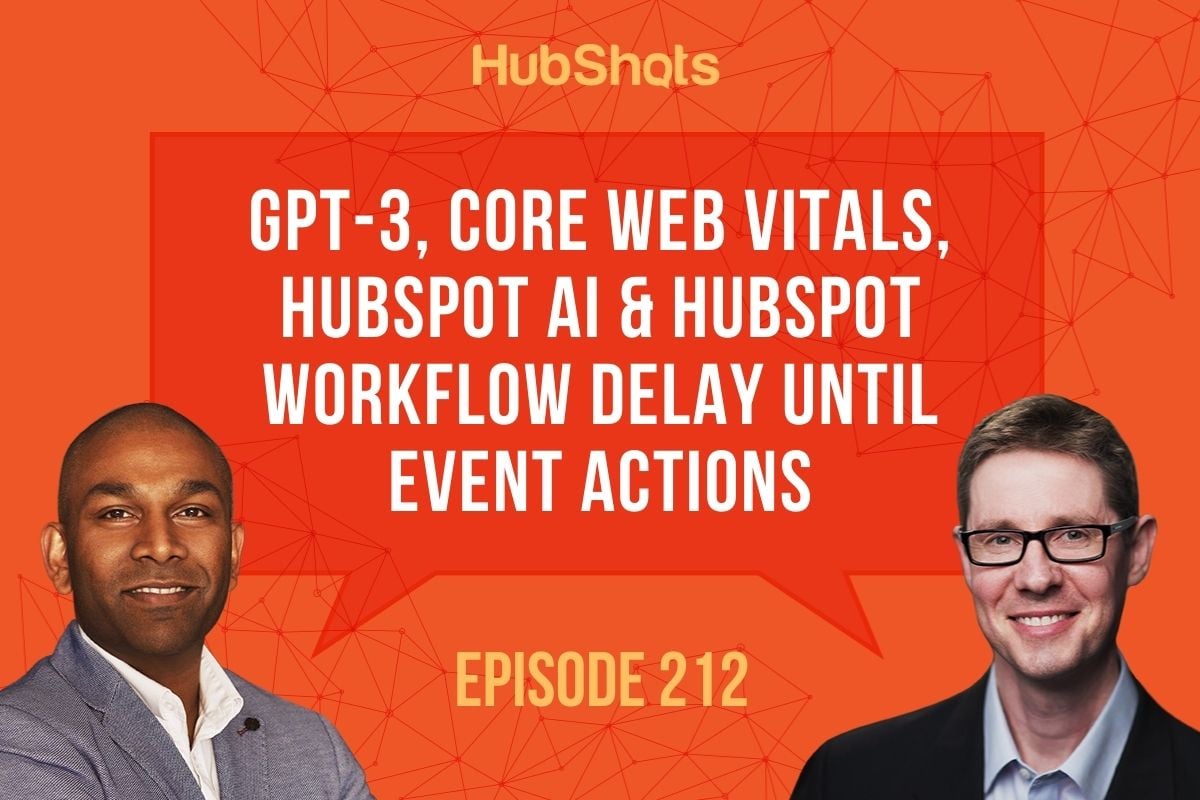
- Hi, everyone. Welcome to HubShots episode 212. In this episode, we talk about GPT-3, and no that's not a fast car. Call web vitals, HubSpot AI, HubSpot delay until event workflow actions, plus drag and drop email gotcha. You're listening to Asia Pacific's number one HubSpot focus podcast, where we discuss HubSpot tips, tricks, strategies, and features for growing your sales service and marketing results. My name is Ian Jakey from Search & Be Found, and with me is Craig Bailey from XEN Systems. How are you Craig?
- Really good, and like last episode, we have so much to get through this episode. So many cool things. We're only gonna touch on them and scratch the surface, especially when we come up to our first one. But first you pulled out a great review that we got, and I'm sure we love to see those, don't we?
- That's right. So thank you to all of our listeners that take the time to leave us reviews. And I'm gonna read one out from a Weather Header here, and we know who you are and here it is. It says bringers of marketing goodness. I'm a longtime fan of Ian and Craig's superb podcasts. Their format and content keeps me connected into the evolving space of digital marketing. Alongside expert HubSpot insight, their podcast concisely discusses, and provokes how we tackle holistic modern marketing, not just the digital trends. Thanks for your many years of contributing to the NZ marketing community. And how cool is that? Thanks, Dan.
- Yeah, thanks so much Dan. And look, we don't do it often. We don't do this thing often where we luxuriate and things like that. But frankly, it just made my day when I saw this. And thank you so much and well, if you wanna write another review, we value them greatly. Thank you so much, and thank you for recommending us to other people as well and sharing about the podcast. Thank you so much.
- All right, Craig, now GPT-3, it's not a new car like I said before, what is this?
- Okay, I'm quickly gonna touch on the topic because it's been getting a lot of excitement in the last week or two. We're recording this on the 23rd of July. So in the last couple of weeks, it's been getting a lot of interest on Twitter. And by the time you actually hear the show, it might've died down a bit. But I think it's worth just quickly giving an overview of GPT-3. You're gonna hear a lot of more of it in the coming year, and for marketers, this is just something for you to be aware of. You can't actually use it yourself yet, I mean, unless you're a beta user. But very quickly what it is, it's the next iteration of an artificial intelligence, I'm gonna say algorithm or a API developed by OpenAI, which is a company. There's a few people, Elon Musk, Sam Altman, I think Reid Hoffman's in there, a bunch of others. Although I don't think that Elon Musk is still, he might've resigned... Anyway, it doesn't matter. A bunch of really smart people have formed it And their whole goal is to build artificial intelligence tools with the caveat that they protect it so it's not abused. So that's an undergirding principle behind it. Anyway, there's been a few iterations, GPT1, GPT2, GPT-3 has a massive, massive data set that it's put together. And it's really just about forming connections between words and concepts. I'm not an expert in it. I don't pretend to. And the part of me explaining it here is not because I'm an expert or I've used it, but just to highlight to marketers, you need to be following this trend. And if nothing else look at some of the show notes links that we've got where we point off to a wired article, some other good examples where people are using this to write content. In fact, one of the links I'll send you to, I'm not gonna tell you, 'cause you have to read it first, halfway through you go, oh, actually this was written by this OpenAI GPT-3. So they put in a few topics and then the AI writes this content. And then this doesn't just apply to content. It's about sequences, people are using it in Excel, they're using an all kinds of things to see, what's when you forward a trend? I've just had a mind blank. I need the AI to help me
- Let me get the AI to help you at Craig.
- Extrapolate, sorry, thank you. Extrapolate, my goodness. flex, it's only 7:30 at night and I still can't... I've lost my...
- It's your haircut, Craig. You're losing lots of heat through the top of your head.
- You know what, I should do one of those special cognitive tests that a president of a certain country did recently. I wonder if I'd even pass, frankly, the way I'm going in this segment. But look, this is exciting stuff. And really marketers ought to be scared about this kind of thing, because it's gonna put a lot of them out of work, the way it's gonna write ads, it's gonna write content, it's gonna write briefs, it's gonna look at trends, it's gonna assimilate information, pull out insights. This is incredible. You've seen some of the demos Ian, what's been your response?
- I'm pretty amazed. And I think you're quite right in saying, Craig, we should all be concerned as marketers. And I think we're seeing this already in certain tools that we use where this is happening with recommendations, with suggestions, and I'm like, wow. It's like we're having to do less and less of the things we used to do. But I recommend everybody watch that video that we have put in the show notes. All right, listeners onto our HubSpot marketing feature the week. And you know how we love workflows to automate stuff. And here is two little things that have been highlighted and this is the workflow delay action, and we mentioned this back in 2006, but now there is a delay until event happens. And Craig, what are those events that we can delay till?
- Yeah, so this is really cool. This is around having a workflow pause, perhaps indefinitely waiting for an event. And the three events are a page visited, a form submitted or a property value changed. And when you think about property value changed, you could basically change a property based on just about anything that you can think of. So as long as you can catch that and switch it. So this is gonna be exciting. I only saw this I think yesterday. So I haven't actually played around to build out an example, just full disclosure. I don't normally like to mention stuff in the show if I haven't actually built anything with it yet. But one of the ones I'm looking at is really around onboarding. You can imagine onboarding sequences here, where you build a welcome, possibly a nurture, but wait for them to do something. You could even use this internally staff, make sure they visit a page, go and view something, pick something, property changes. Okay, next sent email in a sequence or create a task. All kinds of things could happen. So you might even... The possibilities are endless. So even just chatting about them, you think about some of them, people wanna nurture workflow, they come back, they wait until I visit another page that connects a task that goes off to sales and then something else triggers. So lots of opportunity here. And as we build these out, I almost wanna make a shot each show, which will be this episode's delay until the event scenario shot. I just reckon there's gonna be so many useful ways to use this new workflow action.
- Now, Craig, you hired a really interesting one was onboarding and checking to see if people had visited particular pages on your site. And I think that's a really good example because I know for a fact, we always think about people externally to our businesses utilizing our site, but what about people internally to our businesses that actually know what's going on when website updates are happening or pricing changes take place. Are they actually onboard or they're looking at stuff? So this is actually a really good way to maybe trigger something off when that takes place. Now Craig, the HubSpot sales feature of the week. And we've discussed this in the last two episodes of the last episode.
- Yeah, they're speaking of AI from GPT-3 in the opening instance. I wonder if HubSpot's gonna embrace that as part of what you're about to discuss further.
- That's right. So listen, as we spoke about HubSpot AI being enabled on your inbox. Now the previous episode we turned it on, we had a little bit of a gotcha, especially if your account was already preexisting. Now on new accounts, I think when you connect it, it might automatically happen. But we've had it running and it got me excited because it's saved inputting data like job title, addresses, telephone numbers, et cetera, into the contact record. And I've actually got a screenshot of where the HubSpot AI has intervened and filled out all of those details. And I tell you what I've been talking to all of our customers and clients and showing this to them, especially all the sales guys, and they're cheering. They're so excited. So I know it's working and listeners, if you haven't turned this on in your portal, just go and do it. It takes a whole of two minutes and get it started because I think you'll find some benefits from there.
- The thing I really like about this, and you've got this in screenshot in the show notes, is the source. So you can tell which properties have actually been changed by HubSpot AI. 'Cause that was my question. I was wondering, okay, great, it's doing this stuff behind the scenes. How do you actually know what it's done? And of course I shouldn't have been concerned. It's right there. It's marked in the source and next to each property change.
- All right, Craig, onto the HubSpot stumper of the week.
- All right. This was originally gonna be in my gotcha, but I put it in the stumper because I've got another thing that's in the gotcha. But I just wanted to remind or alert people to the HubSpot drag and drop email layouts versus modules confusion that sometimes you might run into. So this will make more sense when you're seeing the screenshot. But if you're in a drag and drop email, which by the way, you should be using drag and drop email. Can you even bear to use the previous emails, Ian? No. Drag and drop. Like everything is drag and drop. Even when we go back, you think, oh, I'll just clone a previous newsletter from six months ago, 'cause the template was great. And like now I'm just building it again from scratch. Drag and drop it's so much better. However, one of the gotchas or things that confused me, I have to say, and it's embarrassing now that I look at it, but because I fell for it, perhaps someone else will as well is I was dragging on content modules onto a, it's just a simple newsletter layout. And I dragged one module from a section below into a section above. Now what I hadn't realized was, and here's why you fall into it because you have single column layouts. I don't know. Do you ever do any more than single column? Do you ever do two columns? No? Best practice is single column emails these days predominantly because a lot of mobile users and single column is the best way. I do see still people building double two column or even worse emails and look, just stop it. I think it's a bad idea. But single column, you think, oh, I've got one layout. This is the trap you fall into. I've got one layout that I can use. No, you can drag many single layout items onto your email and the problem I fell into is I was dragging content items in, but I was dragging between layouts and they were changing formatting. And I didn't realize. Here's the thing, styling is set at the layout level, not the module level. So when you've got single column you think, oh, they're all just single modules. Where's the styling? Well, it's done on the layout and you can just drag multiple layouts in. It's really easy and obvious when you know and if you're familiar with it, you be going, Craig, what is your problem? How did, how did you fall for this? If you're not that familiar, then maybe that's a helper to you. And thanks to Roslyn, you know what? When we were having our daily catch up today with the team, and I said, I've got this problem with drag and drop email layouts. What am I doing wrong? Roslyn, can you just at the end, can you just show me within 30 seconds? She just goes, "No, no, you just drag that layout on." And I was like, oh, I knew it was simple. I'd been stuffing around for 15 minutes trying to sort it out. So there you go.
- All right, listeners now, here's the HubSpot gotcha of the week. And this is HubSpot life cycle changes using a workflow. And just a reminder that if you move a lifecycle backwards from a sales qualified lead to a marketing qualified lead in the workflow, you must clear the lifecycle property first. And we've put an example of how to do that, but you can't just set that property. So you've got to clear it and then update it in an action.
- So this has a bit of a gotcha that was on a client site. We found this, they had somehow accidentally sent a whole bunch of contacts to be evangelist lifecycle. And so then they went, oh yeah, we'll just put them in a workflow and set them all back to marketing qualified lead. And of course it had failed. And that's why it was, yep. You've got to clear it first if you're gonna set it back. Can set it forwards easily, but you can't set it back without clearing first.
- Is that the only one Craig or is there other ones that you've got to do the same?
- I think that might be the only one.
- Do you mean other fields?
- Yeah.
- Yeah. I think life cycles fields' the only one I'm aware of that you have to clear before sending it back.
- Yeah, I think you're right.
- I could be wrong and something might change.
- Listeners, let us know.
- All right, our marketing tip of the week, Craig. Now this is really interesting and we talked about understanding Core Web Vitals. And in essence, it's really about understanding real world user experiences, experience metrics, essentially when viewing a website. And so now we're gonna talk through the three key metrics that this encompasses and why this is important, right? So Craig, do you wanna explain what the three are and then we'll talk a bit more about why it's important for us to understand this going forward.
- Yeah, so this is right. So Core Web Vitals. You're probably seeing it referred to a lot, but you haven't actually taken the time to read about what it is. It's actually really simple, but unfortunately they use a bunch of terms that make it sound complex and techie and oh, a bit of leave that to the tech team. It's really simple and here is all you need to think of it. You need to think it's how quickly can I interact with a web page? And that's what these metrics are about, which we will go through in a second. But the reason it came up is 'cause a client of ours, obviously they'd been getting some advice, someone talking in their ear saying, oh, Google is gonna make user experience part of the ranking algorithm next year. And I'm like, yeah. Okay, so what are you specifically talking about? Because we do know part of that is already in such... And then, oh, are you talking about Core Web Vitals? I don't know, there was lots of weird technical terms. It turns out it was Core Web Vitals. So if you've heard this term, it's really simple and there's three metrics and you can get at these in Google search console. And you should have a good Google search console. Do you wanna mention what they are and I can give a bit of context to each as we go through?
- Sure, the first one is called Largest Content for Paint or known as LCP. The second one is Cumulative Layout Shift, also known as CLS. And third is First Input Delay, which is the FID.
- Well look, if someone's telling you about these, no wonder you're thinking, oh, this is a techie thing. I've got no idea what this is talking about. So let me translate that from geek-speak to simple terms. Largest Content for Paint. Just think of that is how long does it take for the page to render. The second one Cumulative Layout Shift. It's like, how long does it take for the page to size itself. So a simple example, you know how they have an image placeholder. Sometimes you'll see the page loading and then suddenly a jumps when the image displays? That's what they call it a layout shift. So that second one is just how long it sort of displays in the format it's gonna stay displayed in. And First Input Delay, that's really just how long before I can interact with the page. It's loading. You've ever had that when you're loading a page and you can't scroll 'cause it's still stuck there?
- Yes.
- That's all it is. And the point of this is you can get measurements of these in Google search console for your site. Google themselves, and we've got a link to their blog has said, look, they've got benchmarks for each of these metrics. And if you keep your pages under these metrics, you're less likely to have people leave. So for example, that first one, Largest Content for Paint, LCP, which is basically how long to show the page, they're saying, if it's under 2.5 seconds, then most people will stick around for that. Longer than that and they start leaving. So it's just around how fast your site is really to work with.
- Which is what we've been talking about for a long time. Haven't we Craig?
- There's no great insight here that something's changed. It's really just about putting metrics to what we know is our general user experience of using websites.
- Correct. And I think it's great that they have these thresholds, I guess, so people know where they stand. And so users, I would recommend you don't be afraid. Actually start looking at these and see how you can improve them on your site and be aware that they are in search console already.
- And you know what Ian, what do we always say about hosting? That's right.
- It's sometimes good to get decent hosting. It improves all of these metrics.
- And as we said before, the number of clients where we come on there they're scrimping to save. So they only spend nine bucks a month on hosting and then they send thousands of dollars worth of paid traffic to it and wonder why people are leaving?
- Doesn't work.
- Yeah.
- Actually there's an interesting stat I saw with one of my clients today. Had quite a high bounce rate. We switched their host and did some optimization. Their bounce rate has, the graph just looks like that significant. And I was like, oh, look at that massive reduction in bounce rate. Oh, because the page is actually loading quick and people are actually getting to what they want. So they're less likely to leave. And I think it's just a really clear demonstration of the simple things you can do to make a big difference to your site.
- Spot on.
- All right. Insight of the week, Craig. ACS studies are just guesses.
- I'll summarize this in two sentences. It's an article on Search Engine Journal where he breaks down all these SEOs So you know where people say, oh, we've analyzed billions of records and here's what helps Google rankings. This article just says, it just highlights how bogus some of them are. And there's good quiet. It's like great for sales pitches, not great for statistical reality. So SEO studies are guesses. Sometimes the guesses can be useful though. So not disregarding them altogether, but check out the article for further details, if that's of interest.
- All right, on to our HubSpot report or the week, Craig. And this is the Email Health Report, which is in beta. So users, if you have not sent enough emails, there'll be nothing there. Or you've maybe like Craig, you send way too many emails, you might not see anything because it is in beta. But I was looking at this innovative screenshot in the show notes from a customer account and it was really nicely laid out. Really gives you an understanding of your overall health. And so it takes into some key health metric breakdowns. And what they're looking at is open rate, click through rate, hard bounce rate, and unsubscribe rate. And it really nicely has like, it's like a red, orange, green, and a little bar graph about where you are. So understanding at the red end it's action needs to be taken in the middle it's orange, work to be done, and at the end, it's on track. So that's the overall. And then below that it gives you the breakdowns and it tells you what you need to work on. So in the screenshot, I can see open rate, I've got a little bit of work to be done. It was at 22%, but it still says I need some work there. And you can see some details. Click through rate's not bad. Hard bounce rate it says it's on track, but my unsubscribe rate needs action. So really clearly understands what you need to work on. It's really simple things for example. When you send an email and emails bounce, create simple lists, contact views for your sales team to follow up their contacts, to understand, hey, have they departed the company? Have they misspelled their email? Hopefully less of that happens with HubSpot AI, and maybe they moved on, so they don't wanna hear from them, or maybe they have a new contact. So it's a really good way to keep the engagement with sales and the customer happening longterm. And just looking at this all the time and making people understand that this is a regular process of keeping your house tidy, you should look at this after every time you send an email. Look at the metrics, do the followup, do the cleanup and keep it good because it will pay massive dividends in the end.
- Yeah, valuable reminder, Ian.
- All right, Craig, we've got our resource of the week.
- Just quickly in passing Bing webmaster tools have released a WordPress plugin. So you just put that on your site and that allows you to easily submit site URLs to Bing. And yes folks, you should be including Bing in your activities, especially in some industries and especially in some demographics. All the demographics, seniors tend to have the standard out of the box laptop but as Bing as the default search engine and also a lot of tech people I know actually as Bing. Not to be dismissed.
- Now, let's head on to our quote of the week, and this is by Marcus Aurelius, and it says, "Waste no more time arguing what a good man should be, "be one." Or a good woman, I say. All right, listeners, there are lots of good resources and Burness links in the show notes. So we encourage you to look at that. Please connect with us on LinkedIn and thank you to those who have connected with us LinkedIn. And even after they've connected, sent me a message saying, I meant to say that I listened to the podcast.
- Oh, can I just say, 'cause I actually went through LinkedIn today. It's been probably a week or so since and I'm way behind. So I'm so sorry folks, but yes, a whole bunch of people are very friendly and very kind and then... And by the way, I'm not trying to sell you something. I really appreciate it and I will be responding to you. Thank you for that.
- So we do appreciate it. Please continue to connect with us. Tell us your stories. We love to hear from you guys. And if you need help, again, please, don't be afraid to ask Craig or myself. We will be glad to help you or point you in the right direction. Well Craig, until next week--
- Catch you later, Ian.
- Hey there, thanks for listening to this episode of HotShots. To get the latest show notes, HubSpot tips and marketing resources, sign up at hubshots.com. You can also book time with us to help you grow better with HubSpot.
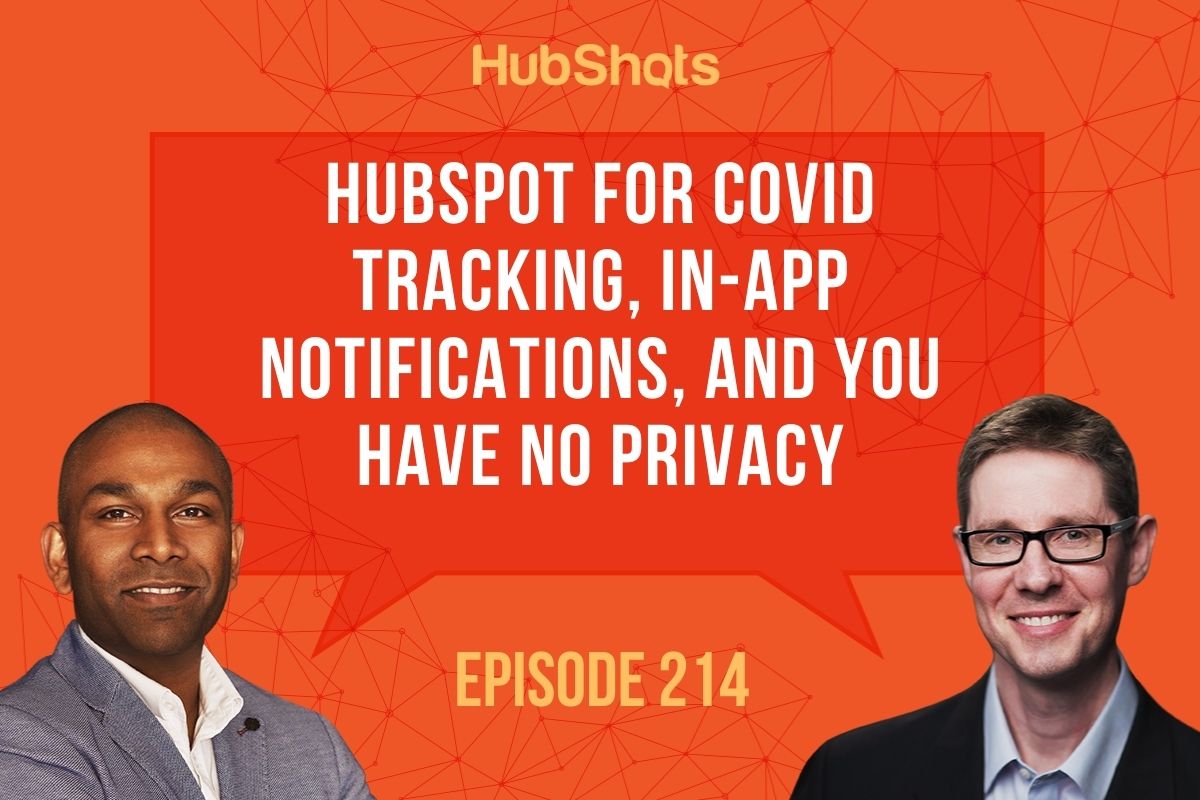
Welcome to HubShots Episode 214: HubSpot for COVID tracking, In-App Notifications, and you have no privacy This episode we discuss having no privacy,...
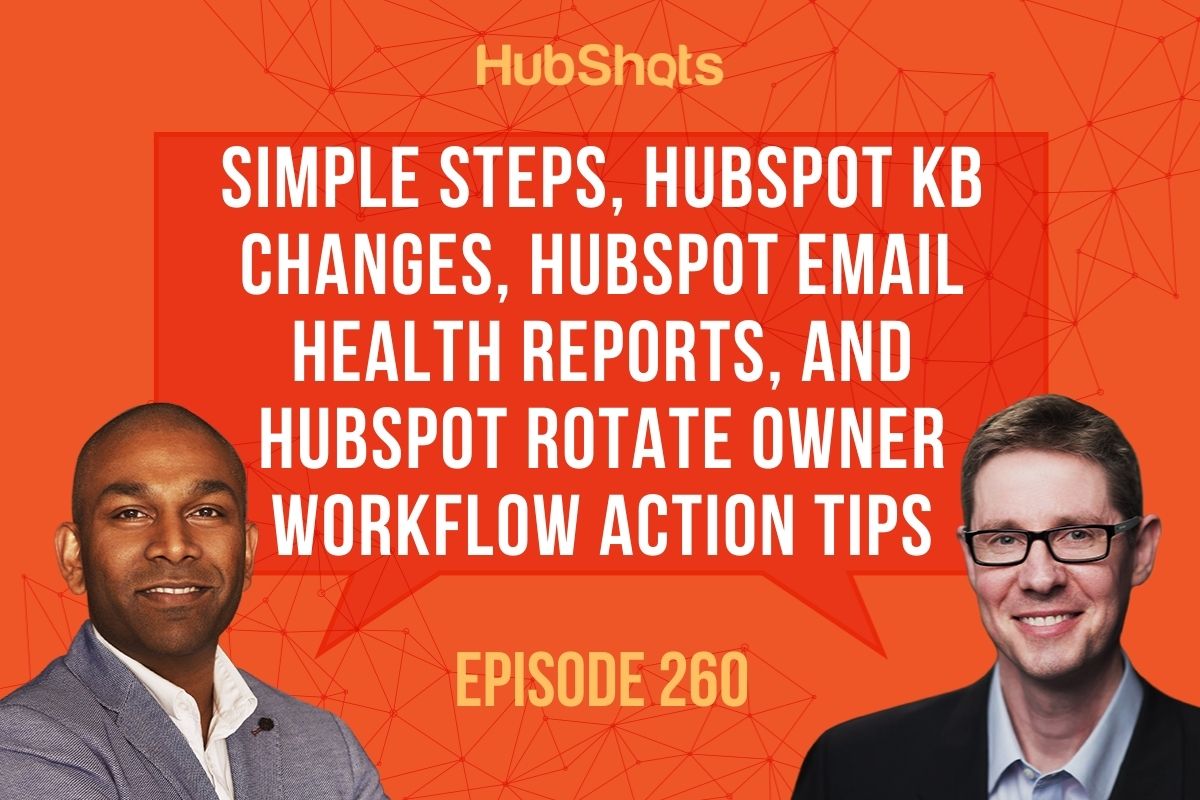
Welcome to HubShots Episode 260: Simple Steps, HubSpot KB changes, HubSpot Email Health Reports, and HubSpot Rotate Owner Workflow Action tips This...
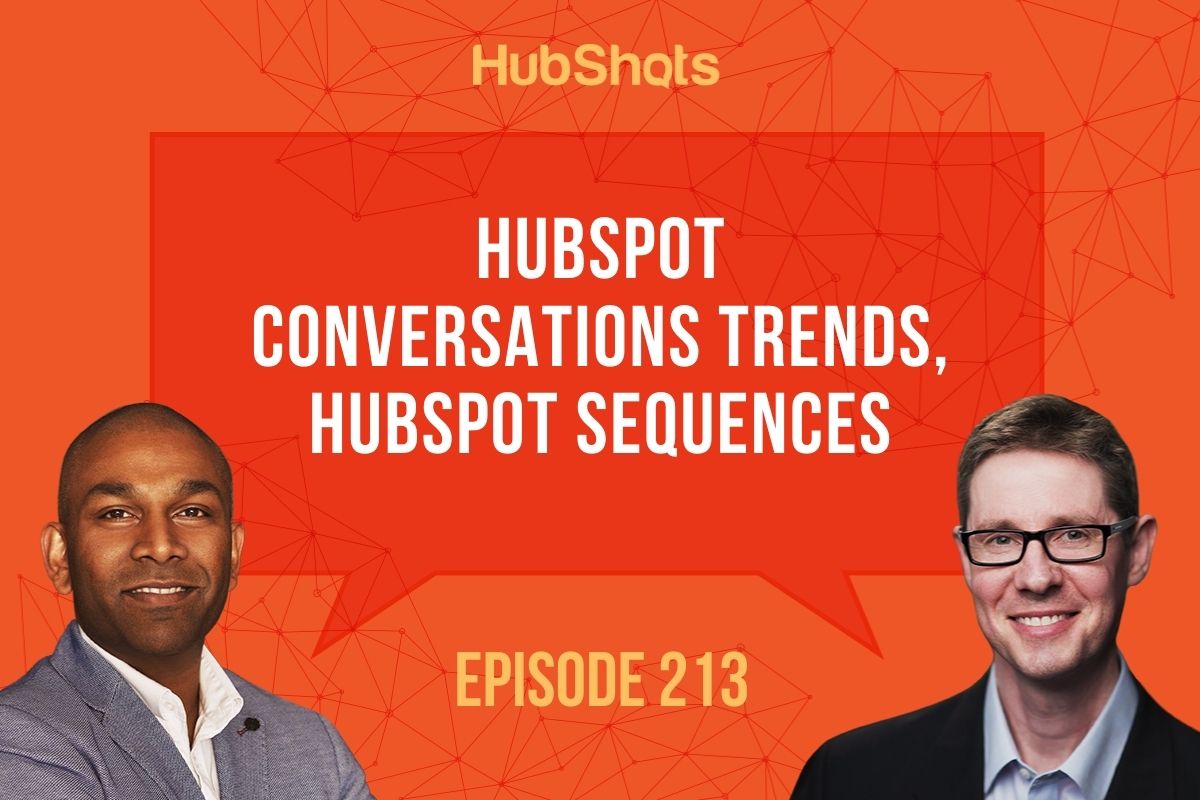
Welcome to HubShots Episode 213: HubSpot Conversations Trends, HubSpot Sequences This episode we discuss Conversations trends, HubSpot Email...